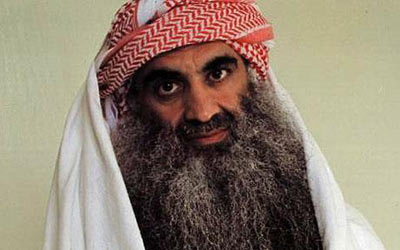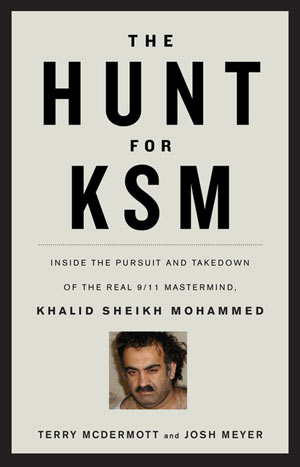
Do you support Truthout’s reporting and analysis? Click here to help fund it.
Khalid Sheikh Mohammed sat stone silent inside the courtroom at the US Naval Base at Guantanamo Bay, refusing to answer routine questions from the judge presiding over his arraignment for war crimes. Four other co-defendants, who are being tried alongside the man now commonly referred to as KSM, took their cues from the self-professed mastermind of the 9/11 attacks and also refused to acknowledge the legitimacy of the military commissions, in what their lawyers described as an act of “peaceful resistance.”
That was the scene at the chaotic, marathon hearing that took place at Guantanamo May 7, and just the latest example of how, over the years, KSM “has controlled the legal proceedings against him, organizing his fellow captives to act as a group and then putting himself in charge,” journalists Terry McDermott and Josh Meyer write in their timely and groundbreaking new book, “The Hunt for KSM.”
KSM “mocked the military courts, preached, instructed, or obstructed as the need arose …” McDermott and Meyer write.
 (Image: Little, Brown and Company)“The Hunt for KSM,” subtitled, “Inside the Pursuit and Takedown of the Real 9/11 Mastermind, Khalid Sheikh Mohammed,” is not just a page-turning spy thriller that masterfully reveals how the FBI and CIA failed to capture Mohammed at least a half-dozen times in the eight years leading up to 9/11, but it’s also a story about the investigative reporters’ own decade-long “hunt” for intelligence about “one of the worst mass murderers in American history.”
(Image: Little, Brown and Company)“The Hunt for KSM,” subtitled, “Inside the Pursuit and Takedown of the Real 9/11 Mastermind, Khalid Sheikh Mohammed,” is not just a page-turning spy thriller that masterfully reveals how the FBI and CIA failed to capture Mohammed at least a half-dozen times in the eight years leading up to 9/11, but it’s also a story about the investigative reporters’ own decade-long “hunt” for intelligence about “one of the worst mass murderers in American history.”
Ten years ago, while working as reporters at The Los Angeles Times, McDermott, Meyer and their colleague Patrick McDonnell published the first substantive profile of KSM, describing him as the “operational commander of Al Qaeda” most responsible for the terrorist organization’s attacks, whose significance was “underestimated” by the FBI.
“He was under everybody’s radar,” a senior FBI official told the reporters at the time. “We don’t know how he did it. We wish we knew…. He’s the guy nobody ever heard of.”
Exactly how KSM “did it” is what McDermott and Meyer were determined to find out. What they discovered in the decade since they published that 9,000-word report in The Los Angeles Times is truly disturbing and, yet again, undercuts the government’s narrative about who knew what and when. KSM eluded capture because no one, except for an FBI agent and a Port Authority detective, was looking for him prior to 9/11, yet everyone in intelligence and federal law enforcement circles knew where he was and knew what he was planning.
The FBI and CIA were so “laser focused” on Osama bin Laden and his al-Qaeda terrorist network, which McDermott said he believes never was and isn’t now an “existential threat to the US,” that the agencies failed to comprehend KSM’s importance. Furthermore, the CIA and FBI never connected the dots related to the intelligence information in their possession that indicated how both men had “joined forces,” one of the intelligence community’s “greatest mistakes, McDermott said.
The lapses continued well after 9/11, due, in part, to the blame game going on between the CIA and FBI over the catastrophic attacks.
“I thought about this for a long time,” McDermott said in an interview. “Not only could 9/11 have been prevented it should have been prevented. I just think the number of mistakes that allowed KSM to evade capture is legion. If they [the CIA/FBI] put the effort into it they would have easily found him.”
Meyer agreed with his co-author. He recently told NPR, “If Khalid Sheikh Mohammed had been taken off the battlefield or captured when the authorities had a chance to do that in the mid-’90s, there simply would not have been a 9/11 attack.”
The FBI is treated more favorably in their book, McDermott said, because the bureau “at least tried” to capture him.
A report I published with my colleague, Jeffrey Kaye, also described how, as early as 1999, a top-secret military intelligence unit likely identified the house where KSM planned the 9/11 attacks, according to documents we obtained. But for reasons that remain a mystery, the intelligence community appears to not have acted upon the information.
McDermott, who is also the author of a book on the 9/11 hijackers, “Perfect Soldiers,” said in addition to fleshing out the narrative about the “bureaucratic ineptitude” that allowed KSM to hide in plain sight while working on other terrorist attack plans, including the 1993 bombing of the World Trade Center, he and Meyer were also determined to craft a deeper story about KSM, the man and the intelligence officials who tracked him.
They split their reporting duties into “cops and robbers,” with McDermott traveling to Pakistan and the Middle East to speak with KSM’s associates and family members, and Meyer, currently co-director of the National Security Initiative at Northwestern University’s Medill School of Journalism, working his sources at the FBI and CIA.
“When you’re researching someone who are you going to talk to?” McDermott said. “You’re going to talk to friends, family and co-workers. You just keep knocking on doors, send letters, faxes, courier deliveries. Eventually, you find enough people who will talk to you that you have a story. And that’s what this was.”
Their gumshoe reporting paid off big time. KSM, the authors discovered, was a “rebellious” youth who, along with a cousin, “climbed the flagpole atop their elementary schoolhouse and tore down the Kuwaiti flag.” KSM was also an excellent student who “excelled” at science. At 16, KSM followed in the footsteps of his brother and began attending camps of the Muslim Brotherhood, which is where he “first heard the call to jihad.”
Humanizing KSM, however, was “stupidly difficult,” McDermott said.
“It was hard in a dumb, mulish way,” McDermott said. “I found KSM’s brother after looking for him for 10 years. And then he wouldn’t talk to me. He threw me off of his doorstep and threatened to have me arrested for invasion of privacy. I said, ‘Jesus Christ, man, your brother’s a mass murderer!'”
After KSM was captured in March 2003, McDermott said the CIA, then headed by George Tenet, ultimately won the internal blame war against the FBI over 9/11 failures, which ultimately allowed the agency to implement a program micromanaged by Vice President Dick Cheney: enhanced interrogation.
“Vice President Dick Cheney went on national television and warned that the United States would no doubt have to venture onto the ‘dark side’ in order to pursue and punish its enemies,” McDermott and Meyer write. “Cheney, more than any other individual, was the architect of the new War on Terror. He made it clear that doubt and nuance had no role to play in this new world. The FBI’s customary ways of doing business were not a fit for what Cheney had in mind, and perhaps chiefly for that reason the Bureau lost its status as the preeminent antiterror agency.”
McDermott said he believes the catalyst that led the Bush administration to implement the torture program was trying to find out “what’s the next attack?” I don’t agree with McDermott’s assertion as I am of the mind that the torture program was about exploitation, obtaining false confessions and turning captives into informants.
“The CIA was looking for something that didn’t exist,” McDermott said during our interview, explaining why KSM was brutalized. “The CIA’s sole focus was on the next attack. Here’s the problem: there was no next attack, there were hundreds of them. There were a multitude of plots. The CIA was looking for the next ‘spectacular’ and there was none. I’ve always wondered why torture was used too. Aside from the immorality of it, we know torture doesn’t work. The person being tortured will say anything to make the torture stop. But [the CIA] used it anyway. The outcome was almost fated.”
The information the CIA obtained by torturing KSM was “bad, made up,” he would later say, “so the torture would stop.” His false confessions, the cornerstone of the program, however, sent intelligence and law enforcement officials on “wild goose chases”—literally—in an attempt to stop nonexistent terrorist attacks.
“He had us chasing the goddamn geese in Central Park because he said some of them had explosives stuffed up their ass,” former FBI counterterrorism agent, Ali Soufan, told the authors.
McDermott and Meyer write that in addition to being waterboarded, a form of controlled drowning, 183 times, KSM was deprived of sleep for a week, “hog-tied, stripped naked, photographed, hooded, beaten, kicked, suffocated, exposed to extreme cold and noise, denied food and sleep, sedated with anal suppositories, placed in diapers and hung by his wrists until they bled.”
“KSM bragged later about sending American agents scurrying around the globe on the impossible task of trying to distinguish the truths from the half truths and lies,” McDermott and Meyer write.
Those details are what makes “The Hunt for KSM” required reading. Its revelations are an important reminder that the government has been in control of the narrative for far too long.
The years KSM spent at CIA black site prisons around the world, where his interrogators used methods of torture to extract false confessions, all but ensures that “his full story will never be told” and justice will never truly be served to the mass murderer.
“For reasons that perplex even its best friends, the United States has kept Mohammed in the shadows of its secret prisons for so long it seems likely he can now never be fully exposed to the light for fear of what he might say about what went on in the darkness.”
KSM secured his final victory a couple of years ago when Congress thwarted Attorney General Eric Holder’s efforts to prosecute KSM and four other 9/11 co-defendants in federal court in New York City. Democrat and Republican lawmakers feared his trial in Article III courts would make the city vulnerable to another terrorist attack.
It is through KSM’s “ability to strike fear, which is the first goal of all terrorism,” McDermott and Meyer write, that the true mastermind of the 9/11 attacks has been able to retain “his power,” even to this day, as evidenced by the initial response to Holder’s announcement about the venue in which KSM would be prosecuted.
“KSM, years after he was last able to issue a single order, remained, in some real sense, in command.”
Our most important fundraising appeal of the year
December is the most critical time of year for Truthout, because our nonprofit news is funded almost entirely by individual donations from readers like you. So before you navigate away, we ask that you take just a second to support Truthout with a tax-deductible donation.
This year is a little different. We are up against a far-reaching, wide-scale attack on press freedom coming from the Trump administration. 2025 was a year of frightening censorship, news industry corporate consolidation, and worsening financial conditions for progressive nonprofits across the board.
We can only resist Trump’s agenda by cultivating a strong base of support. The right-wing mediasphere is funded comfortably by billionaire owners and venture capitalist philanthropists. At Truthout, we have you.
We’ve set an ambitious target for our year-end campaign — a goal of $230,000 to keep up our fight against authoritarianism in 2026. Please take a meaningful action in this fight: make a one-time or monthly donation to Truthout before December 31. If you have the means, please dig deep.